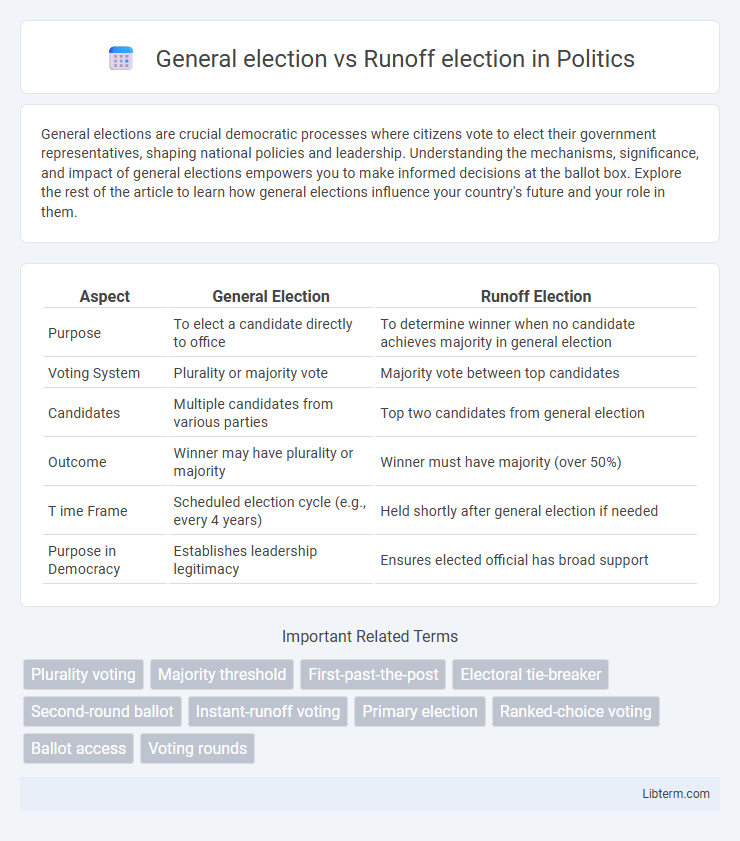General elections are crucial democratic processes where citizens vote to elect their government representatives, shaping national policies and leadership. Understanding the mechanisms, significance, and impact of general elections empowers you to make informed decisions at the ballot box. Explore the rest of the article to learn how general elections influence your country's future and your role in them.
Table of Comparison
| Aspect | General Election | Runoff Election |
|---|---|---|
| Purpose | To elect a candidate directly to office | To determine winner when no candidate achieves majority in general election |
| Voting System | Plurality or majority vote | Majority vote between top candidates |
| Candidates | Multiple candidates from various parties | Top two candidates from general election |
| Outcome | Winner may have plurality or majority | Winner must have majority (over 50%) |
| T ime Frame | Scheduled election cycle (e.g., every 4 years) | Held shortly after general election if needed |
| Purpose in Democracy | Establishes leadership legitimacy | Ensures elected official has broad support |
Introduction to Election Types
General elections determine the primary winner for political offices through a majority or plurality vote, usually held at regular intervals. Runoff elections occur when no candidate achieves the required threshold, often a majority, prompting a second round between top contenders. This voting system ensures elected officials have broader support, enhancing electoral legitimacy in democratic processes.
Defining General Elections
General elections are the primary voting events where citizens select public officials across various government levels, including presidential, congressional, and local offices. These elections determine the initial winners who secure the required majority or plurality of votes to assume office. If no candidate achieves the necessary majority in the general election, a runoff election may be held between the top contenders to finalize the winner.
Understanding Runoff Elections
Runoff elections occur when no candidate achieves the required majority in the general election, triggering a second round between the top contenders. These elections ensure that the winning candidate secures more than 50% of the vote, providing a definitive mandate. Understanding runoff elections is crucial in regions with majority-vote requirements, as they prevent winners by mere plurality and enhance electoral legitimacy.
Key Differences Between General and Runoff Elections
General elections determine the primary officeholder by voting among all qualified candidates, often requiring only a simple majority to win. Runoff elections occur when no candidate achieves the necessary threshold, typically over 50%, in the general election, leading to a contest between the top two vote-getters. The key difference lies in their purpose: general elections select initial winners, while runoff elections resolve inconclusive results to ensure a majority-supported candidate.
Election Process: General vs Runoff
The general election typically involves multiple candidates from various parties competing simultaneously to secure the highest number of votes, often resulting in a clear winner if one candidate achieves the required majority or plurality. A runoff election occurs only if no candidate meets the threshold, usually between the top two candidates from the general election, ensuring one candidate obtains a majority vote in a separate, subsequent voting process. This two-step election process promotes majority support, enhancing the legitimacy of the elected official.
Voter Participation and Turnout
General elections typically see higher voter participation and turnout because they determine the primary officeholders and attract broad public interest across multiple races. Runoff elections usually experience lower turnout as they occur between fewer candidates, often after no contender achieves a majority in the general election, leading to voter fatigue or decreased motivation. Studies reveal turnout in runoff elections can drop by 10-20% compared to the general election, impacting overall electoral representation.
Advantages and Disadvantages of Each Election Type
General elections offer the advantage of simplicity and broad voter participation, as all candidates compete simultaneously, making it easier to determine a winner in a single round. However, they can lead to a winner without majority support, especially in multi-candidate races, potentially reducing the perceived legitimacy of the elected official. Runoff elections ensure majority support by requiring a second round between the top candidates if no one achieves a majority initially, but they can increase election costs, voter fatigue, and lower turnout in the runoff phase.
Impact on Political Candidates and Parties
General elections offer political candidates and parties a broad platform to secure widespread voter support, often requiring extensive campaign resources and strategic coalitions to appeal to diverse electorates. Runoff elections, occurring when no candidate achieves a majority, intensify competition by narrowing the field to top contenders, pressuring parties to consolidate alliances and refine messaging to win over undecided or eliminated candidates' supporters. This dynamic influences party strategies, candidate positioning, and voter mobilization efforts, ultimately shaping electoral outcomes and political power distribution.
Global Examples of General and Runoff Elections
General elections, held worldwide, determine the primary representatives in governmental bodies, such as the United States presidential election or India's Lok Sabha elections, where voters select candidates across multiple parties. Runoff elections occur when no candidate achieves the required majority, seen in countries like France's presidential elections and Brazil's municipal elections, ensuring a final winner with broader electoral support. These electoral systems reflect diverse democratic practices globally, emphasizing majority legitimacy and voter representation.
Conclusion: Which Election System Works Best?
Runoff elections tend to produce winners with broader voter support by requiring a majority rather than a simple plurality, reducing the likelihood of vote splitting in multi-candidate races. General elections are more straightforward and cost-effective but may result in candidates winning without majority backing, potentially decreasing perceived legitimacy. The best election system depends on priorities: runoff elections enhance representativeness and voter confidence, while general elections offer simplicity and efficiency.
General election Infographic

 libterm.com
libterm.com